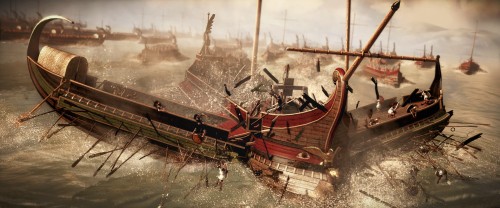naval warfARE
Some states such as Athens, Aegina, Corinth, and Rhodes amassed fleets of warships, most commonly the trireme, which could allow these states to forge lucrative trading partnerships and deposit troops on foreign territory and so establish and protect colonies. They could even block enemy harbours and launch amphibious landings. The biggest fleet was at Athens, which could amass up to 200 triremes at its peak, and which allowed the city to build and maintain a Mediterranean-wide empire.
The trireme was a light wooden ship, highly manoeuvrable and fitted with a bronze battering ram at the bow which could disable enemy vessels. Thirty-five metres long and with a 5 metre beam, some 170 rowers (thetes - drawn from the poorer classes) sitting on three levels could propel the ship up to a speed of 9 knots. Also on board were small contingents of hoplites and archers, but the principal tactic in naval warfare was ramming not boarding. Able commanders arranged their fleets in a long front so that it was difficult for the enemy to pass behind (periplous) and ensure his ships were sufficiently close to prevent the enemy going through a gap (diekplous). Perhaps the most famous naval battle was Salamis in 480 BCE when the Athenians were victorious against the invading fleet of Xerxes.
However, the trireme had disadvantages in that there was no room for sleeping quarters and so ships had to be dry-docked each night, which also prevented the wood becoming water-logged. They were also fantastically expensive to produce and maintain; indeed the trireme was indicative that now warfare had become an expensive concern of the state, even if rich private citizens were made to fund most of the expense.
The trireme was a light wooden ship, highly manoeuvrable and fitted with a bronze battering ram at the bow which could disable enemy vessels. Thirty-five metres long and with a 5 metre beam, some 170 rowers (thetes - drawn from the poorer classes) sitting on three levels could propel the ship up to a speed of 9 knots. Also on board were small contingents of hoplites and archers, but the principal tactic in naval warfare was ramming not boarding. Able commanders arranged their fleets in a long front so that it was difficult for the enemy to pass behind (periplous) and ensure his ships were sufficiently close to prevent the enemy going through a gap (diekplous). Perhaps the most famous naval battle was Salamis in 480 BCE when the Athenians were victorious against the invading fleet of Xerxes.
However, the trireme had disadvantages in that there was no room for sleeping quarters and so ships had to be dry-docked each night, which also prevented the wood becoming water-logged. They were also fantastically expensive to produce and maintain; indeed the trireme was indicative that now warfare had become an expensive concern of the state, even if rich private citizens were made to fund most of the expense.
All credit and sourcing goes to: http://www.ancient.eu/Greek_Warfare/

